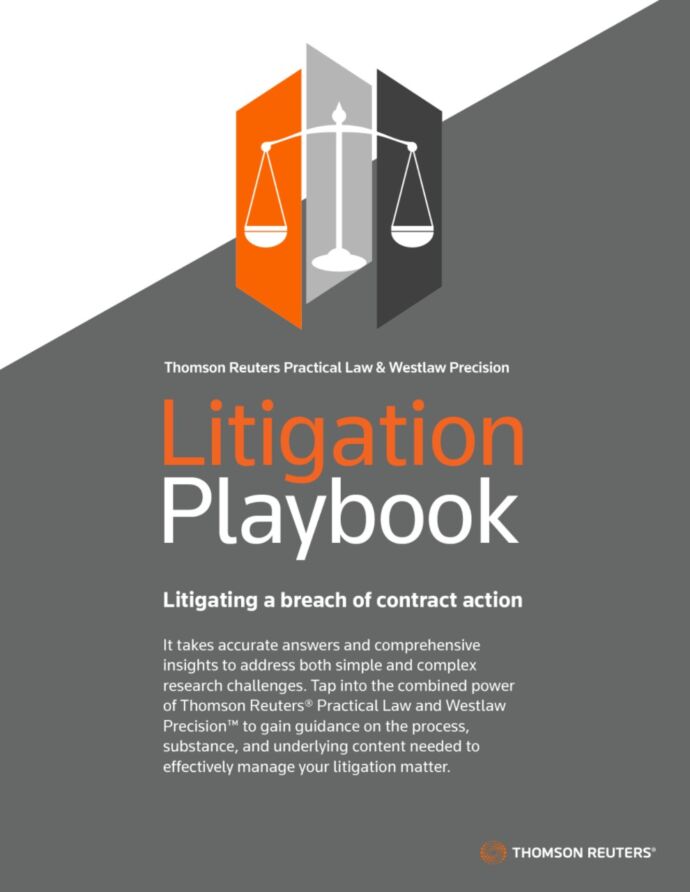A checklist for in-house counsel
I began my career as an in-house lawyer on the litigation side. So, I have seen a lot of litigation over the years, usually involving breach of contract disputes. All in-house lawyers should know what to do when you think the other side has breached the agreement. While your first instinct may be to fire off a lawsuit, there are many steps in-house counsel should take before doing that. Below I set out a checklist to walk you through what to consider when the other side has breached the agreement.
Jump to ↓
| Review the Facts |
| Review the Contract |
| Prepare the Legal Analysis |
| Who Needs to Know? |
| Can You Resolve it quickly? |
| Prepare for litigation |
 |
- Review the Facts. The first thing you must do when analyzing a potential breach of contract claim is understand the facts. This means speaking with as many people as possible to triangulate and confirm the facts as best you can. And always remember that there will be another side to the story so don’t accept anything as gospel and keep an open mind as to the strength and weaknesses of your company’s position.
- Get all the Internal Documentation:
- Collect internal records relating to the contract and alleged breach, i.e., emails, memos, meeting minutes, agendas, presentations, correspondence, Slack or Teams posts, and any other communications related to the contract/breach.
- Review records relating to the parties’ performance under the contract such as project management reports, technical reports, performance reports, delivery receipts, and other documentation showing the fulfillment of contractual obligations or breach of the same.
- Get External Documentation (if possible):
- Get all the Internal Documentation:
- If possible, have the business request information from the other party regarding the particular issue, i.e., documents, clarifications, etc. While unlikely that the other side will provide much, it’s worth trying.
- If there are third parties involved in the dispute, e.g., subcontractors, see what information you can obtain from them. It may be nothing, but the goal is to be as comprehensive as you can be.
- Conduct Interviews of Key Individuals:
- As important as documents will be to your analysis, interviewing internal stakeholders is critical:
- Determine who within the organization has knowledge of the contract and the alleged breach.
- Develop a list of questions to understand what happened and why the business believes a breach occurred.
- Interview as many people as you can to get the entire story. End your interviews with, “Is there anyone else you think I should speak with and are there any documents you have that can support what you are telling me?”
- If you can, speak with the relevant third parties and get their version of what has transpired.
2. Review the Contract. As part and parcel of your fact-gathering efforts, you must also – of course – review the contract in question.
- Get a copy of the contract: Make sure you have the most recent and complete version, including all amendments and exhibits.
- Identify key terms and obligations at issue: As you review the agreement pay close attention to the specific duties of the parties, deadlines, and conditions precedent.
- Identify the breach: Understand which provision(s) of the contract are allegedly breached. How does each party’s performance align with the contractual requirements? In the back of your mind look out for the possibility that your team breached the agreement:
- Pinpoint specific actions or inactions that constitute the alleged breach.
- Assess the potential impact of the breach: Consider the financial, operational, and reputational implications of the breach.
- Clarify ambiguous terms: If the contract isn’t clear and your legal department drafted the agreement, speak with the attorney who prepared the deal. Likewise, speak with anyone who was part of the negotiations (if any), if you have not already spoken with them.
- What is the dispute resolution process?
- Notice requirements.
- Litigation.
- Arbitration.
- Applicable law.
- Venue.
- Escalation process.
- Attorneys’ fees for the prevailing party.
- Contractual statute of limitations.
- What is the dispute resolution process?
3. Prepare the Legal Analysis. Now that you are familiar with the facts, the documents, and the contract, it’s time to use your lawyer super powers to analyze the potential breach.
- Are you convinced a breach did occur? Can you prove it? If not, stop and report back to the business. If yes, continue on.
- Assess the materiality of the breach:
- What type of breach is it?
- Material.
- Minor.
- Anticipatory.
- Is the breach excused, e.g., force majeure?
- What are the consequences of the breach?
- Notice and cure period.
- Evaluate the actual and potential damages resulting from the breach:
- Direct.
- Consequential.
- Punitive.
- Liquidated.
- Statutory.
- Other.
- Evaluate the potential causes of action and remedies available to you.
- Monetary damages (see above).
- Equitable relief, i.e., injunction, specific performance, etc.
- Terminating the contract.
- Rescind the contract.
- Interest on any damages.
- Attorneys’ fees.
- Stop performing.
4. Who Needs to Know? Once you have completed your legal analysis and assuming you have found a material breach of the agreement, you must inform the right people within the business and align on the next steps.
- Notify the general counsel. Start with your boss and ultimately the general counsel (unless that is you) and lay out your thinking and recommendation. Listen closely to their feedback.
- Notify the affected business or staff group. Layout your findings, the options, your recommendation, and get their agreement on what to do. In particular, get their thinking on whether to pursue a lawsuit or try to resolve the dispute without litigation.
- If the breaching party is a large customer or vendor, the business may want to resolve the dispute in a way that avoids toxic litigation that could destroy any chance of a continued business relationship.
- Notify the C-Suite (if warranted). Depending on the size of the dispute, notify the C-Suite (and potentially the board of directors). Let them know the options, the plan, and get their sign-off if necessary.
- Be sure to give the strengths and the weaknesses of the case.
- Put yourself in the other side’s shoes and consider how they will respond. What are their best/most likely next steps once you file?
- Others. Inform other groups that should know about the dispute, potentially:
- Corporate communications.
- Finance.
- Human resources.
- Internal Audit.
- Investor relations.
- Others.
- Explain the litigation process. If the decision is to move forward with filing a lawsuit or arbitration claim, make sure the business understands what this process will entail.
- The cost.
- The timeline of events (from complaint through appeal).
- The litigation process:
- Complaint
- Answer.
- Counter Claims.
- Depositions.
- Document requests.
- Requests for admission.
- Juries.
- Judges.
- Experts.
- Their time commitment.
- Lack of confidentiality (unless in confidential arbitration).
- Define winning. It is very important that the legal department and the business are in agreement on what constitutes winning.
5. Can You Resolve it quickly? Before you file the lawsuit, it is always worth taking a moment to consider whether there is a way to resolve it without litigation.
- By meeting:
- In-house lawyer to in-house lawyer
- By meeting:
- Senior executive meeting
- A mix of both.
- Non-binding mediation.
- Voluntary arbitration (if both sides would like to avoid a public fight).
- Settlement authority:
- What is your authority to resolve it?
- What is acceptable to the business?
6. Prepare for litigation.
- Give notice:
- Prepare a demand letter.
- Consider the response carefully – is there a path to a quick resolution?
- Send any required notices and follow the dispute resolution process in the contract.
- Engage outside counsel:
- Negotiate the rates/fixed cost
- Get a budget.
- Set up a project plan to manage the litigation.
- Ensure compliance with guidelines and billing standards.
- Prepare the complaint:
- Draft the lawsuit with outside counsel.
- Ensure key business colleagues have read it and blessed it.
- Remember that, if in court, what you file is likely public:
- File under seal if confidentiality obligations require it.
- Put a litigation hold in place:
- Identify the right people to get the hold:
- Make sure they acknowledge receipt.
- Work with the IT department to stop auto-destruction.
- Send regular reminders.
- Brush up on privilege questions:
- Work product doctrine.
- Train the business on both (and on the importance of writing smart).
- Develop litigation strategy:
- Themes of the case.
- Jury research.
- Judge research.
- Settlement strategy (if any).
- Think through the different potential outcomes and their impacts. Nothing is ever guaranteed in litigation so plan accordingly.
- Establish an update process:
- Set up a process for regular communication with your outside counsel. No surprises.
- Create a process for regular updates to the business, the C-Suite, the board of directors as warranted. No surprises.
- Keep the general counsel advised. No surprises.
7. Other.
- Conduct a post-mortem. No matter what happened over the course of investigating the potential breach, whether or not you filed a lawsuit, and whether or not you one, this is the perfect time to take stock of where the company sits in terms of good contract hygiene and processes:
- Determine if there are systemic problems with how contract performance is monitored, managed, and documented by the business:
- Is better record-keeping needed?
- Do your contracts need updating?
- Better dispute resolution provisions.
- Clean up ambiguities in language.
- Reconsider damages provisions (e.g., caps and disclaimers).
- Is the company’s record retention policy helpful or hurtful?
- What changes are needed?
- How is it monitored and enforced?
- Do you need to train the business in writing smart?
- Are the company’s own documents helping or hurting when dealing with disputes?
Dealing with contract disputes is never fun (or easy). When faced with a potential breach of your contract by the other party, don’t lead with filing a lawsuit. There are many steps to take before you get to that point and the above checklist should cover most of what you need to do. Take the time to properly manage the process and get on the right path forward. If you have access to Practical Law you have many great resources (toolkits, checklists, summaries of the law, etc.) to help you manage the contracting process from creation to termination and everything in between.
 |












